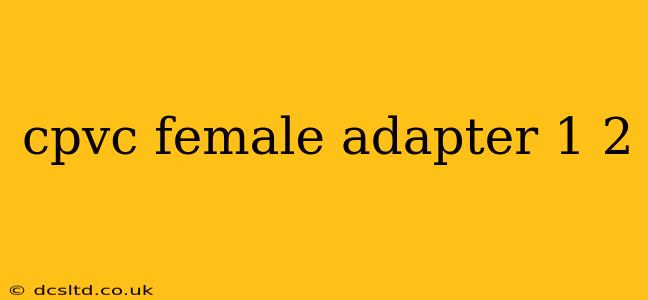Finding the right fitting for your CPVC plumbing project can feel overwhelming. This guide focuses on the CPVC female adapter 1/2", exploring its applications, specifications, and considerations for choosing the best one for your needs. We'll delve into common questions and provide detailed answers to help you make an informed decision.
What is a CPVC Female Adapter 1/2"?
A CPVC female adapter 1/2" is a plumbing fitting made from chlorinated polyvinyl chloride (CPVC), a type of plastic known for its high temperature and pressure resistance. The "female" designation refers to its threaded interior, allowing it to connect to a male-threaded pipe or fitting. The 1/2" refers to its nominal pipe size, meaning the inside diameter is approximately 1/2 inch. This adapter is crucial for joining different types of plumbing components, particularly when transitioning between threaded and non-threaded sections.
What are the Applications of a CPVC Female Adapter 1/2"?
This versatile fitting finds use in a wide range of applications, including:
- Connecting CPVC pipes to threaded fittings: This is the primary use case. If you have a section of CPVC pipe that needs to connect to a threaded valve, appliance, or other fixture, the female adapter provides the necessary transition.
- Repairing or extending existing CPVC plumbing: When repairing a leak or extending a pipe run, the adapter can seamlessly integrate new components into the existing system.
- Creating branch connections: By combining the adapter with other fittings, you can easily create branch lines for additional plumbing fixtures.
- Use in hot and cold water systems: CPVC's high temperature resistance makes this adapter suitable for both hot and cold water applications. However, always check the manufacturer's specifications for the exact temperature limits.
What are the Different Types of CPVC Female Adapters?
While the 1/2" size is standard, you might encounter variations in:
- Material: Although mostly CPVC, some adapters might include other materials like brass inserts for enhanced durability or thread strength.
- Thread type: While most are NPT (National Pipe Taper) threads, other standards exist. Ensure compatibility with your existing system.
- Schedule: CPVC pipes and fittings are available in different schedules (thicknesses) to handle different pressure requirements. Choose an adapter with a schedule matching your pipe.
How Do I Choose the Right CPVC Female Adapter 1/2"?
Selecting the correct adapter involves considering several factors:
- Pipe schedule: Ensure the adapter's schedule matches the schedule of your CPVC pipes.
- Thread type: Verify that the thread type on the adapter is compatible with the threads of the fitting you are connecting to.
- Manufacturer's specifications: Always consult the manufacturer's specifications to ensure the adapter is suitable for the intended application and operating conditions (temperature and pressure).
- Quality: Opt for high-quality adapters from reputable manufacturers to ensure durability and longevity.
What is the difference between a CPVC female adapter and a CPVC coupling?
A CPVC coupling connects two CPVC pipes of the same diameter without the need for threading. A female adapter, on the other hand, connects a CPVC pipe to a threaded fitting, bridging the gap between threaded and non-threaded components. They serve distinct purposes.
Where can I buy a CPVC female adapter 1/2"?
CPVC female adapters are widely available at most plumbing supply stores, both online and brick-and-mortar. Many home improvement centers also carry a selection of CPVC fittings.
Are there any safety considerations when using a CPVC female adapter?
Always follow the manufacturer's instructions and safety precautions when working with CPVC fittings and pipes. Properly tighten the connections to avoid leaks. Ensure the adapter is compatible with the intended application and operating conditions.
This comprehensive guide provides a detailed overview of CPVC female adapters, helping you navigate the choices and make an informed purchase for your plumbing needs. Remember to always prioritize safety and consult manufacturer specifications before installation.
